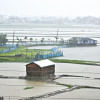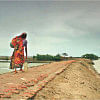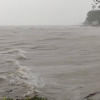Forests make embankments sturdy. Why are we getting rid of them?

While we need some time to understand the extent of damage Cyclone Sitrang has caused, I assume that the overall damage would be much less than previous such calamities. I have learnt from the Bangladesh Water Development Board (BWDB) that Sitrang could not do much damage to the beribadhs (embankments) and polders in the affected areas. This is because the polders in this region are in a relatively good condition, compared to those in the western and southwestern areas of the country. And perhaps the wind speed of the cyclone was not as fast as feared at first. If the cyclone had made its landfall in the southwestern coastal areas, it would have caused more damage. So, we could say we were somewhat lucky this time.
In order to soften the impact of any cyclone, there is no alternative to constructing embankments and polders along our coastal region. If you go and talk to the local people there, they will say only one thing: the embankments must be protected at all costs. No matter how much we frown upon the idea of embankments, the reality is that, if we want to save lives from cyclones and tidal surges and lessen the damage caused by them, we will need these embankments.
But while the embankments built along the central coastal areas of Bangladesh are quite sturdy, those in the south and southwestern areas are not in very good conditions. That is because when they were built, the majority of cyclones used to hit our central coastal districts, i.e. Chattogram, Noakhali, Barishal, etc. But later, the country experienced more and more cyclones in its southern and southwestern coastal districts. Since the trend shows that cyclones will be more frequent now, we need to strengthen all the embankments along our coasts. Also, they should be designed, built and maintained in the right way. If you do not maintain the coastal embankments properly, they will decay over time – their heights will decrease, and they will become weak.
After we have ensured that our embankments are in good condition, we will also have to take some soft measures such as strengthening our forecasting system – issue warnings properly, accurately and timely – and ensuring afforestation along the embankments.

Our cyclone forecasting system needs much improvement. It must be designed in a way that local people can easily understand it. The warnings must be given in simple and believable language. Local people hardly understand the meaning of cyclone caution signals. Say, for instance, what will local people understand from the Distance Cautioning Signal Number One? What they want to know is if the particular village they live in will be affected, whether their houses will be damaged, what the height of the tidal surge in their village will be, what the wind speed in their particular area will be, whether the embankments will break down, etc. With all this information in hand, they can make their own decisions during a cyclone. Local people cannot just benefit from knowing what will happen in their districts or divisions. Unfortunately, we have not been able to develop such a smart, localised warning system as yet.
Afforestation along our coastlines is crucial, too. There are many social and economic benefits of afforestation. We have seen how the Sundarbans saved our coastal region from the devastating impacts of cyclones in the past. The strength of a cyclone becomes weaker as it passes through the forests. The whole world is now focusing on green solutions to these problems, and we also need to take this seriously. Although we do not have much space left for afforestation, what we can do is green our coastlines along the embankments with proper planning. The forests can lessen the chances of the embankments collapsing or developing breaches.
Cyclones are inevitable for us; we cannot stop them from occurring. But if we can ensure proper development in these three sectors, the havoc they wreak can be significantly mitigated.
Transcribed and translated by Naznin Tithi.
Dr Anisul Haque is professor at the Institute of Water and Flood Management (IWFM) of Bangladesh University of Engineering and Technology (Buet).

 For all latest news, follow The Daily Star's Google News channel.
For all latest news, follow The Daily Star's Google News channel. 









Comments